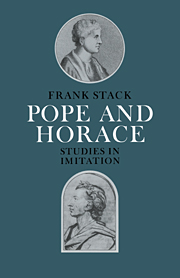Book contents
- Frontmatter
- Contents
- Acknowledgements
- List of abbreviations
- Preface
- PART I INTRODUCTIONS
- PART II THREE HORATIAN SATIRES (1733–4)
- 3 Raillery and energy: The Imitation of Satire II.i.
- 4 Horace, moral: The Paraphrase of Satire II.ii.
- 5 Horace, immoral: The Imitation of Satire I.ii. (Sober Advice)
- PART III MATURE HORACE (1736–7)
- PART IV THE TIME OF TENSION (1738)
- Epilogue
- Appendix: Imitations of Horace published 1730–40
- Notes
- Bibliography
- Index
3 - Raillery and energy: The Imitation of Satire II.i.
Published online by Cambridge University Press: 08 January 2010
- Frontmatter
- Contents
- Acknowledgements
- List of abbreviations
- Preface
- PART I INTRODUCTIONS
- PART II THREE HORATIAN SATIRES (1733–4)
- 3 Raillery and energy: The Imitation of Satire II.i.
- 4 Horace, moral: The Paraphrase of Satire II.ii.
- 5 Horace, immoral: The Imitation of Satire I.ii. (Sober Advice)
- PART III MATURE HORACE (1736–7)
- PART IV THE TIME OF TENSION (1738)
- Epilogue
- Appendix: Imitations of Horace published 1730–40
- Notes
- Bibliography
- Index
Summary
Dans cette premiere Satire il y a une plaisanterie continuelle …
André Dacier (VII, p. 18)have you seen my imitation of Horace? I fancy it will make you smile; but though, when I first began it, I thought of you; before I came to end it, I considered it might be too ludicrous, to a man of your situation and grave acquaintance, to make you Trebatius, who was yet one of the most considerable lawyers of his time, and a particular friend of the poet. In both which circumstances I rejoice that you resemble him, but am chiefly pleased that you do it in the latter.
Pope to Fortescue, Sunday 18 February, 1733.In December 1731 Pope's Epistle to Burlington caused a major stir for what was taken to be its ridicule of Lord Chandos and Cannons in the portrait of Timon and his villa. The critical reception of this poem made Pope hold back from publication the even more dangerous Epistle to Bathurst, with its severe criticism of such powerful figures as Peter Walter and Francis Chartres. By the winter of 1733 however, he must have felt it was time to proceed. It was just at this point, when Pope was ill in bed that Bolingbroke, visiting him, happened to pick up a copy of Horace by his bed, and, turning to Satire II.i., remarked how similar Pope's case was to Horace's as described in that poem.
- Type
- Chapter
- Information
- Pope and HoraceStudies in Imitation, pp. 29 - 59Publisher: Cambridge University PressPrint publication year: 1985

